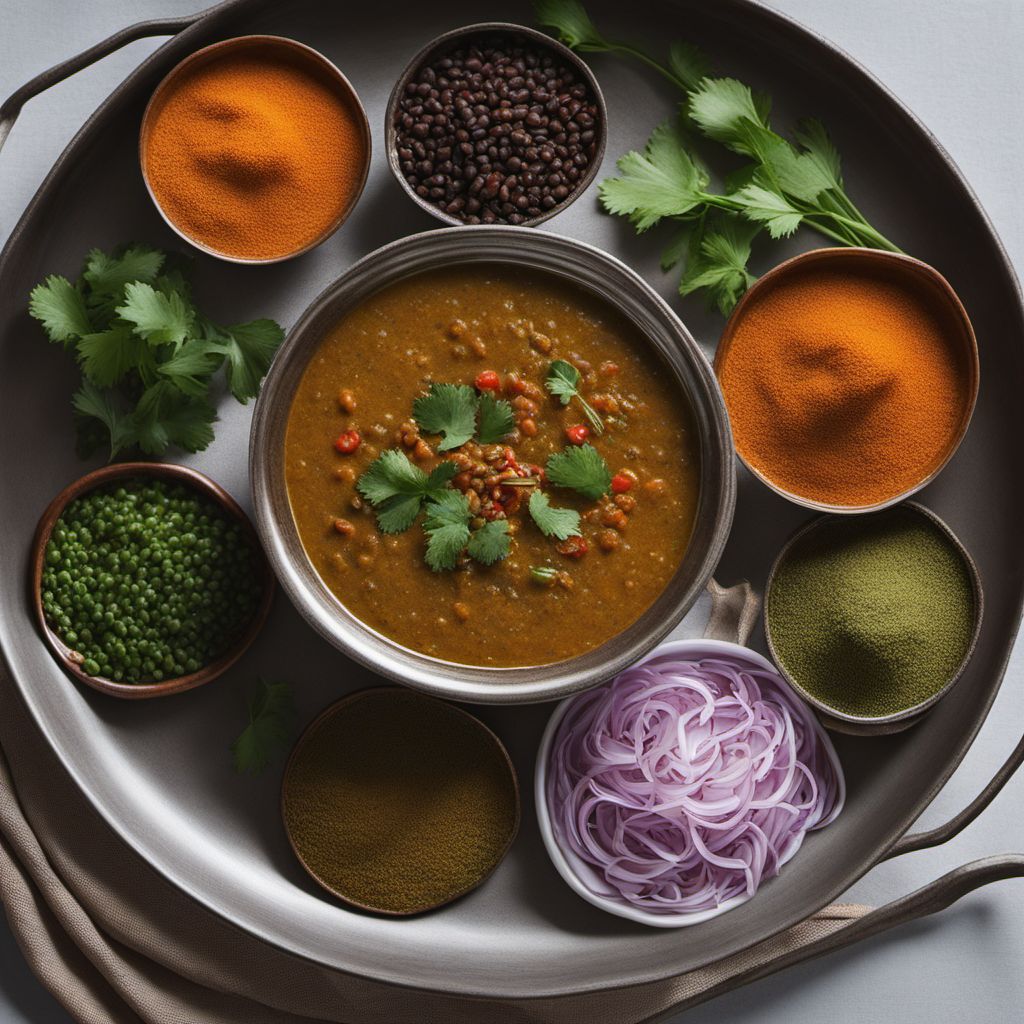
Recipe
Tabani - Newari Style Lentil Stew
Savory Lentil Delight: A Newari Twist on Tabani
4.7 out of 5
Indulge in the flavors of Newari cuisine with this delectable lentil stew, Tabani. Bursting with aromatic spices and hearty lentils, this dish is a staple in Newari households, known for its rich flavors and comforting nature.
Metadata
Preparation time
15 minutes
Cooking time
40 minutes
Total time
55 minutes
Yields
4 servings
Preparation difficulty
Easy
Suitable for
Vegetarian, Vegan, Gluten-free, Dairy-free, Nut-free
Allergens
N/A
Not suitable for
Paleo, Keto, Low-carb, High-protein, Atkins
Ingredients
In the Newari adaptation of Tabani, we incorporate traditional Newari spices such as timur (Szechuan pepper), jimbu (Himalayan herb), and gundruk (fermented leafy greens). These ingredients add a distinct flavor and aroma to the dish, giving it a unique Newari twist. Additionally, the original Bosnian recipe uses different spices and herbs that are not commonly found in Newari cuisine. We alse have the original recipe for Tabani, so you can check it out.
-
1 cup (200g) lentils, washed and soaked 1 cup (200g) lentils, washed and soaked
-
1 onion, finely chopped 1 onion, finely chopped
-
2 tomatoes, diced 2 tomatoes, diced
-
3 cloves of garlic, minced 3 cloves of garlic, minced
-
1-inch ginger, grated 1-inch ginger, grated
-
1 teaspoon cumin powder 1 teaspoon cumin powder
-
1 teaspoon coriander powder 1 teaspoon coriander powder
-
1 teaspoon turmeric powder 1 teaspoon turmeric powder
-
1 teaspoon timur (Szechuan pepper) 1 teaspoon timur (Szechuan pepper)
-
1 teaspoon jimbu (Himalayan herb) 1 teaspoon jimbu (Himalayan herb)
-
1 tablespoon gundruk (fermented leafy greens) 1 tablespoon gundruk (fermented leafy greens)
-
2 tablespoons vegetable oil 2 tablespoons vegetable oil
-
Salt to taste Salt to taste
-
Fresh cilantro, for garnish Fresh cilantro, for garnish
Nutrition
- Calories (kcal / KJ): 250 kcal / 1046 KJ
- Fat (total, saturated): 6g, 1g
- Carbohydrates (total, sugars): 38g, 4g
- Protein: 12g
- Fiber: 10g
- Salt: 1.5g
Preparation
-
1.Heat vegetable oil in a large pot over medium heat.
-
2.Add chopped onions and sauté until golden brown.
-
3.Stir in minced garlic and grated ginger, and cook for another minute.
-
4.Add diced tomatoes and cook until they soften.
-
5.Drain the soaked lentils and add them to the pot.
-
6.Pour enough water to cover the lentils and bring to a boil.
-
7.Reduce the heat to low and simmer until the lentils are tender and cooked through.
-
8.Stir in cumin powder, coriander powder, turmeric powder, timur, jimbu, and gundruk.
-
9.Season with salt to taste and simmer for an additional 10 minutes.
-
10.Remove from heat and garnish with fresh cilantro.
Treat your ingredients with care...
- Lentils — Soaking the lentils before cooking helps to reduce the cooking time and ensures they cook evenly.
- Timur (Szechuan pepper) — Crush the timur before adding it to the stew to release its aromatic flavors.
- Jimbu (Himalayan herb) — If jimbu is not available, you can substitute it with dried fenugreek leaves for a similar flavor.
- Gundruk (fermented leafy greens) — If gundruk is not accessible, you can substitute it with spinach or kale for a milder taste.
Tips & Tricks
- For a thicker consistency, mash some of the cooked lentils with the back of a spoon before adding the spices.
- Adjust the spice levels according to your preference by adding more or less timur (Szechuan pepper).
- Serve Tabani with steamed rice or traditional Newari roti for a complete meal.
- To enhance the flavors, let the stew sit for a while before serving to allow the spices to meld together.
- Leftover Tabani can be refrigerated and enjoyed the next day, as the flavors tend to deepen over time.
Serving advice
Serve Tabani hot in individual bowls, garnished with fresh cilantro. Accompany it with steamed rice or Newari roti for a satisfying meal.
Presentation advice
To elevate the presentation, sprinkle a pinch of timur (Szechuan pepper) on top of the stew before serving. You can also serve it in traditional Newari brass bowls for an authentic touch.
More recipes...
For Bosnian cuisine » Browse all
More Bosnian cuisine dishes » Browse all

Kvrguša
Kvrguša is a traditional Bosnian dish that is typically served as a side dish or snack. It is made with a combination of flour, water, and salt,...

Čorbast pasulj
Bean soup
Čorbast pasulj is a traditional Serbian dish made with beans and meat. It is a hearty and flavorful stew that is perfect for a cold winter day.

Bosanski lonac
Bosnian Pot
Bosanski lonac is a traditional Bosnian stew that is made with a variety of meats and vegetables. It is a hearty and filling meal that is perfect...






